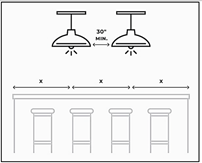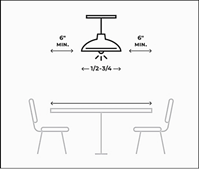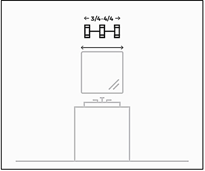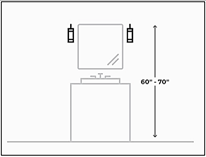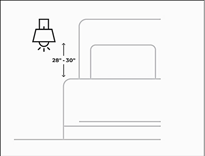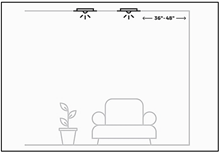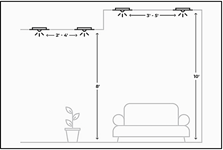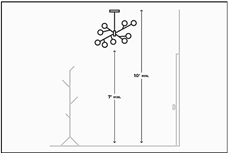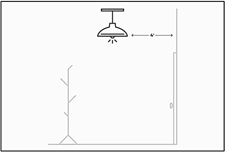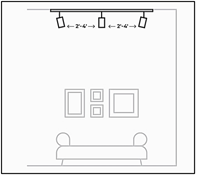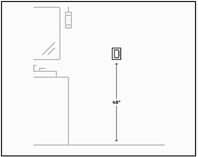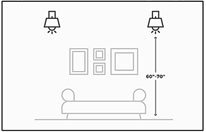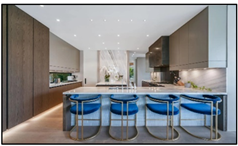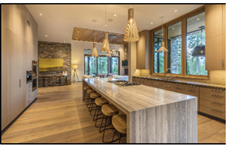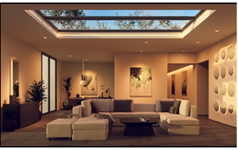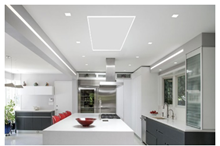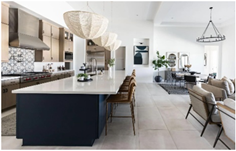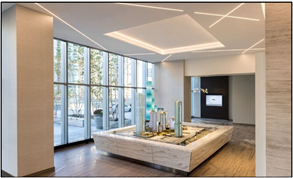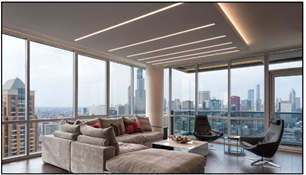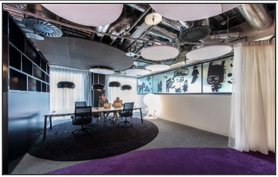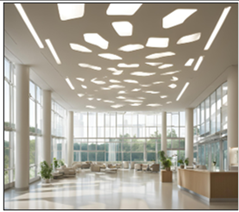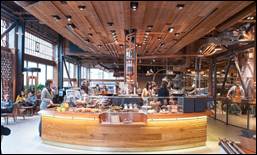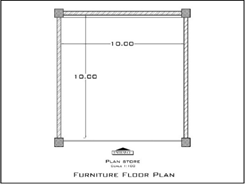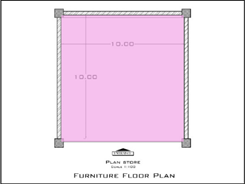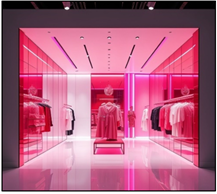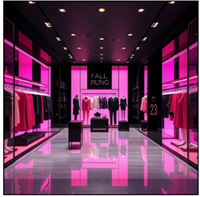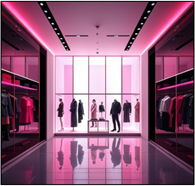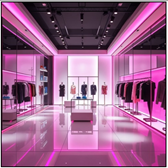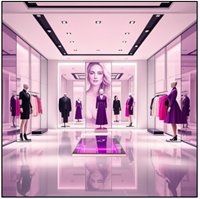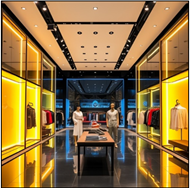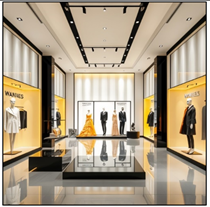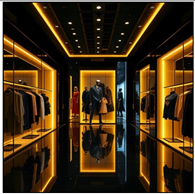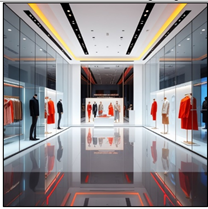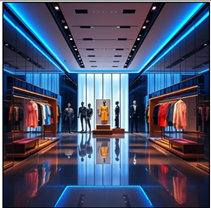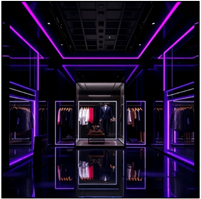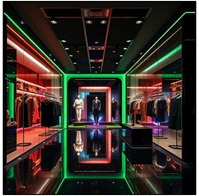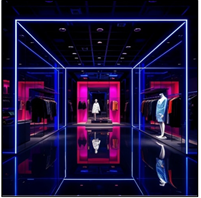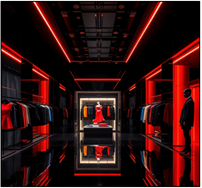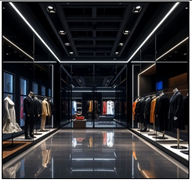|
|
|
|
The Role of Lighting Design on Human Psychology in Interior Spaces (Fashion Retail Store Case Study)
Ola Mahmoud Mohammed Ahmed 1![]()
![]() , Amna Ali Talib Al Sheyadi 2
, Amna Ali Talib Al Sheyadi 2![]()
1 Assistant
Professor, Department of Design, Oman College of Management and Technology,
Sultanate Oman
2 Student,
Department of Design, Oman College of Management and Technology, Sultanate Oman
|
|
ABSTRACT |
||
|
Lighting is a
powerful tool for creating atmosphere and enhancing the sense of space, not
just ensuring that objects are visible. The study examines the impact of
light on interior design and the relationship between lighting effects and
human psychology in this context, with a focus on how these effects influence
human well-being. It also identifies lighting types and concepts that enhance
human emotions. The research employs a descriptive, theoretical, and
analytical approach to exploring the relationship between lighting and human
psychology in interior design studios, presenting several case studies that
illustrate how thoughtful lighting design influences human psychology.
Interior design relies heavily on lighting, which has a significant impact on
interaction and mental well-being. This involves balancing artificial and
natural illumination, incorporating biophilic elements, and considering
psychological aspects. Therefore, studying the effects of sustainability can
emphasize the relationship between natural and constructed environments,
maximizing the use of natural light and minimizing the reliance on artificial
light sources. Finally, the study will present a case study of the workshop
in a design psychology course (603203), in Department of Design, Oman College
of Management and Technology, which aimed to apply the concept of psychology
and lighting design involving color in retail store spaces, that discover the
impact of lighting on customers in fashion stores. In conclusion, the study contributes to the
understanding of the relationship between lighting and psychology in interior
design, providing criteria for interior designers to enhance their experience
and promote the development of innovative, well-rounded designers. Designers
must consider the psychological impact of light in alignment with the purpose
of space. The perfect lighting design creates a well-balanced environment for
humans, increasing productivity. The results of the workshop were
outstanding, as they analyzed consumer psychology through various lighting
and color design approaches. |
|||
|
Received 15 February 2025 Accepted 10 March 2025 Published 30 April 2025 Corresponding Author Ola M.
Mohammed Ahmed, omohammed@ocmt.edu.om DOI 10.29121/ijetmr.v12.i4.2025.1560 Funding: This research
received no specific grant from any funding agency in the public, commercial,
or not-for-profit sectors. Copyright: © 2025 The
Author(s). This work is licensed under a Creative Commons
Attribution 4.0 International License. With the
license CC-BY, authors retain the copyright, allowing anyone to download,
reuse, re-print, modify, distribute, and/or copy their contribution. The work
must be properly attributed to its author.
|
|||
|
Keywords: Lighting
Psychology, Lighting Design, Well-Being, Sustainability, Retail Store Design |
|||
1. INTRODUCTION
Circadian
lighting systems take into account the human circadian
rhythm, adjusting the color temperature throughout
the day to create environments that promote rest and productivity, such as
hospitals, schools, and workplaces. Interior lighting offers a comprehensive
understanding of the lighting principles and practices required to create visually
appealing and functional interiors Ozenen (2023). The
interaction between color, light, and human emotions
can have a profound impact on comfort, productivity, and mood. The research
explores the psychological effects of lighting in interior design, with a
specific focus on the diverse types of lighting, their emotional impact, and
the importance of balancing artificial and natural lighting sources Boyce (2003). This study
offers a comprehensive overview of interior lighting, encompassing various
lighting techniques, fixtures, controls, and types that enhance the
functionality and aesthetics of interior spaces. This comprehensive guide
offers a thorough understanding of the role of lighting in interior design,
providing insight into how it can enhance the functionality, aesthetics, and
ambiance of an interior space Ozenen (2023). The study
aims to enhance the understanding of the relationship between lighting and
psychology in interior design, thereby improving designers' experiences and
fostering the development of innovative, well-rounded designers Mahmoud (2023). Therefore, natural lighting systems enhance
the health, productivity, safety, and customer satisfaction of buildings, as
well as healthcare facilities, promoting a positive environment for occupants
and improving patient recovery rates Edwards and Torcellini (2002). Light has a
significant impact on human perception, psychological well-being, and cognitive
maps. An ecological approach to light perception encompasses light design and
art, as well as the analysis of mental, emotional, and behavioral
responses in various experiential contexts Elnaggar and Arts (2022). Therefore,
the study highlights the significance of lighting design in creating a
comfortable and visually appealing environment, emphasizing the need for
solutions that harmonize with color schemes and
enhance functionality. It emphasizes psychological and design aspects through
lighting in interior design Madumarova (2023). The study will provide a case study of a
workshop in a design psychology course (603203) at the Oman College of
Management and Technology's Department of Design. The workshop's goal was to
apply psychological concepts and lighting design principles in retail store
spaces to determine how lighting affects customers in fashion stores. The
workshop's outcomes were outstanding as they examined consumer psychology
through various lighting design techniques.
1.1. Problem Statement
Lighting is crucial in human psychology as it influences emotional
reactions and overall well-being. Poorly designed lighting can
cause headaches, eye strain, and anxiety. However, thoughtful lighting can
enhance focus, improve sleep, and increase happiness. Currently, there are no
specific criteria or standards for designing lighting in interior spaces that
guide designers in selecting the proper lighting elements to evoke emotions in
the user and enhance psychological factors and mood. Moreover, the study
examines the psychological impact of lighting on interior design, specifically
investigating the relationship between lighting effects and human psychology to
address these issues through enhancing sustainability and green spaces.
Interior
design is heavily reliant on lighting, which significantly impacts both the
aesthetic appeal of a room and the psychological well-being of its occupants.
The study examines the impact of various lighting types on design perception, a
crucial aspect of human psychology, particularly in interior design, where
lighting types and concepts evoke emotional responses. By applying this
knowledge, the study aims to determine the impact of lighting psychology
concepts on consumers in a fashion retail store project.
·
What is the role of lighting in interior design?
·
How can lighting affect human psychology?
·
What is the relationship between lighting design and psychological
factors?
·
What are the various lighting techniques, fixtures, controls, and
types that enhance the functionality and aesthetics of interior spaces?
·
What are the key elements in the design that enable lighting
design to control human emotions?
·
How can sustainability and green spaces affect the lighting
design?
·
How can good lighting design enhance human comfort, productivity,
and mood?
·
What are the effects of color lighting
on consumers in fashion retail stores?
1.4. Research Objectives
·
Identify lighting types and concepts that enhance emotions.
·
Study the impact of lighting psychology on humans to change their
mood, perception, Emotions, mentality, concentration, well-being, and ability
to live better.
·
Provide adequate and appropriate illumination, enabling visual
tasks to be performed safely, comfortably, and efficiently while enhancing the
visual appearance of the environment
·
Equip architects, interior designers, and lighting designers with
a comprehensive understanding of the principles and techniques of lighting
design for diverse interior spaces.
·
Discuss different types of lighting sources, including artificial
and natural lighting, and their specific applications in interior design.
·
Cover multiple lighting techniques, including accent, task,
decorative, and ambient lighting, and provide practical examples of their
application in different interior spaces.
·
Examine professional lighting features, including high-quality
lighting fixtures, layered lighting, lighting controls, and color
temperature control, to illustrate how these elements collaborate to create a
harmonious and functional lighting design.
·
Provide a comprehensive overview of lighting design strategies and
offer practical insights that can be applied to real-world design projects,
such as retail stores.
1.5. Research Limits
The research limits are
determined by the study's scope, which focuses on the psychological effects of
lighting in interior design.
The research employs a
descriptive, theoretical, analytical approach to examine the relationship
between lighting effects and human psychology in interior design, with a focus
on how these effects impact human well-being. The study started with investigating
the impact of various lighting types' design on the perception of design. The primary focus of the study was lighting,
examining its effects on human emotions and the complementary relationship
between color and light. Furthermore, lighting,
design environment, perception, technological advancements in lighting design,
and techniques and methods in lighting design, including sustainable lighting
design and the significance of lighting design for well-being through biophilic
design. Various case studies and projects will be discussed, describing the
impact of lighting and psychology on comfort, productivity, and mood. The study
focuses on a case study from the Design Psychology Course Workshop at OCMT, as
shown in Figure 53, Figure 54, Figure 55, Figure 56, Figure 57, Figure 58, Figure 59, Figure 60, Figure 61, Figure 62, Figure 63, Figure 64, Figure 65, Figure 66, Figure 67, Figure 68, Figure 69, Figure 70, Figure 71, Figure 72.
3. Basic Principles of Lighting in Interior Design
3.1. Lighting Design
Lighting design involves creating
lighting systems that meet a space's functional and aesthetic needs, taking into account energy efficiency, sustainability, and
human factors. Adequate lighting design strikes a balance between technical and
artistic considerations, as well as understanding the physiological and
psychological effects of light on humans Ozenen (2023).
Figure 1

|
Figure 1 Illustrates
the Lighting Design in Residential Spaces Almrsal (2024). |
3.2. Lighting Standards and Regulations
Numerous rules, standards, and
regulations are in place to ensure that lighting systems are safe, efficient,
and sustainable, promoting energy efficiency, human health, and environmental
protection. Lighting standards and regulations are guidelines and requirements
that govern the design, installation, and operation of lighting systems in
buildings, outdoor spaces, and transportation facilities Ozenen (2023).
3.3. Lighting Measurement Types
The guide emphasizes that not every
fixture is the same and not every homeowner wants the standard installation, as
shown in Table
1, Lightology (2025).
Table 1
|
Table 1 Lighting Measurement Types in Residential Design Lightology (2025). |
|||
|
N |
Type |
Description |
Drawings |
|
1 |
Kitchen
Lighting
|
To achieve the desired light height
above a kitchen island, it is recommended to hang a chandelier or pendant 30
- 36 inches above the island surface. To determine the length of a linear
suspension, divide the island into even segments, one higher than the number
of pendants desired, as shown in Figure 2, Figure 3, Figure 4, Lightology (2025). |
Figure 2 Illustrates Lighting Measurement in Kitchen Lightology (2025). |
|
2 |
Dining Room
|
A dining room pendant light should be 6
inches across, similar to a kitchen island, and positioned 1/2 to ¾ of the
circumference of the table, as shown in Figure 5,
Lightology (2025). |
Figure 5 Illustrates Lighting Measurement in Dining Room Lightology (2025). |
|
3 |
Bathroom
|
Hang vanity lights at eye level, 60-70
inches from the ground, on the side of the mirror, ¾ of the way across the
mirror's width, avoiding the edges, as shown in Figure 6,Figure 7, Lightology (2025). |
Figure 6 Illustrates Lighting Measurement in Bathroom Lightology (2025). |
|
4 |
Bedroom
|
The ideal height for a bedside sconce
is 28-30 inches above the top of the mattress, ensuring eye-level reading. It
should be within reaching distance from the bed, not too close to be in your
way while sleeping, and not too far from the bed, as shown in Figure 8, Lightology (2025). |
Figure 8 Illustrates Lighting Measurement in Bedroom Lightology (2025). |
|
5 |
Recessed
|
Recessed lighting can be customized
based on various factors, such as wall wash effects or artwork lighting. A
general rule of thumb is to maintain a distance of 36
to 48 inches between the light and the wall. For 8-foot ceilings, a 4-foot
spacing is required, and for 10-foot ceilings, a 5-foot spacing is necessary,
as shown in Figure 9,
Figure 10, Lightology (2025). |
Figure 9 Illustrates Recessed Lighting Lightology (2025).
Figure 10 Illustrates Recessed Lighting Lightology (2025). |
|
6 |
Suspensions
|
To ensure proper light output and
adequate breathing room, it is recommended to provide 4 feet of clearance,
especially when hanging fixtures near doors, as shown in Figure 11, Figure 12, Lightology (2025). |
Figure 11 Illustrates Suspensions Lighting Lightology (2025). |
|
7 |
Track
|
A versatile solution can be adjusted to
suit various applications, including artwork, reading, cooking, and general
lighting. Spacing them 2' to 4' apart ensures ample lighting, with the
ability to adjust the distance as needed, as shown in Figure 13, Figure 14, Lightology (2025). |
Figure 13 Illustrates Track Lighting Lightology (2025). |
|
8 |
Wall
|
Light switch height typically ranges
from 48 to 48 inches, making it accessible to people of all ages. Wall
sconces should be placed 8-10 feet apart for even lighting, taking into
account both lumen output and the wall layout, as shown in Figure 15, Figure 16, Lightology (2025). |
Figure 15 Illustrates Wall Lighting Lightology (2025). |
|
9 |
Outdoor
|
Outdoor wall lights should be placed on
either side of the door or on the same side as the doorknob for optimal
illumination. Path lights should be spaced 6-8 feet apart but may need to be
closer together depending on the lumen output. For indoor walkways, a safe
bet is to place them closer to the doorknob for better illumination, as shown
in Figure 17, Lightology (2025). |
Figure 17 Illustrates Outdoor Lighting Lightology (2025). |
4. Lighting and its Effects on Human Emotions
Lighting designers possess a
transformative power within the realm of interior
design. By altering the nature and classification of light stimuli within a
continuum of variations, they can instigate profound changes in the perceiver's
psychophysiological responses. This ability to measure subjective impressions
under various lighting conditions inspires new possibilities and pushes the
boundaries of design Elnaggar and Arts (2022). LED lighting is not just a technological advancement; it
is a revolution in the way we create and manipulate light. It is turning light
into an art form, a medium that is becoming increasingly popular in homes,
hotels, and offices, inviting us to appreciate and understand light in a new
way Allen (2024).
4.1. Light as an Illustrative Tool
The light source, the energy it emits,
and the biopsychological effects produced by light become the focus of all the
perceptual mechanisms and interpretive processes carried out by each perceiver:
light plays a role not only in making an object visible to the viewer but also
in placing it in its context within the environmental space, as shown in Figure 18, Elnaggar and Arts (2022).
Figure 18
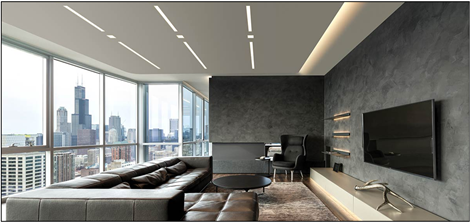
|
Figure
18 Illustrates
the Significance of Light in the Perception of Spaces. Allen (2024) |
4.2. Lighting, Design Environment, and Perception
The relationship between light levels
and colors has been demonstrated that light
influences biochemical and hormonal processes, body temperature, mood,
psychological well-being, and brain electrical activity, as well as affects
neurotransmitters Elnaggar and Arts (2022). Human environmental experience is closely tied to the
realm of light, as space is primarily perceived through the visual sense, as
illustrated in Figure 19, Figure 20, Figure 21.
Figure 19
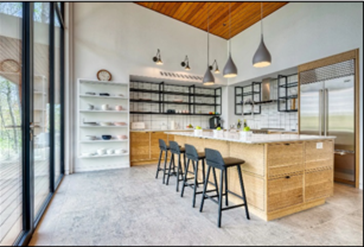
|
Figure
19 Illustrates
the Design Environment of the Kitchen Through Different Light Design Units Allen (2024). |
Figure 20
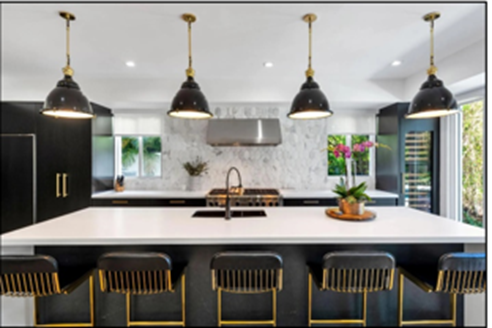
|
Figure
20 Illustrates
the Design Environment of the Kitchen Through Different Light Design Units Allen (2024). |
Figure 21
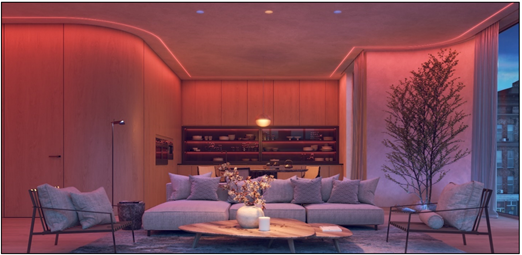
|
Figure
21 Illustrates the
Impact of Warm Lighting in Changing Moods and Perceptions for Humans to Feel
Comfortable in the Space Lightology (2018). |
4.3. Harmonious Combination of Color and Light
The harmonious combination of color and light is not just a design element but a crucial
factor in creating a well-balanced interior design. The proper selection of
lighting fixtures, color temperature, and color rendering indices can significantly enhance color perception and presentation in a space. Given the
interactions of color and light, designers can
maximize the desired feeling, environment, and functionality by avoiding
imbalances that can cause visual discomfort. Successful color
and light coordination requires careful consideration.
Designers should consider the desired focal points, hierarchy, and intended
activities within the space, as shown in Figure 22, and Figure 23, Madumarova
(2023).
Figure 22
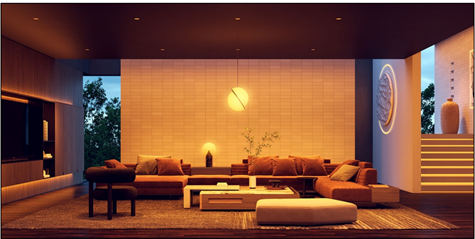
|
Figure
22 Illustrates
Harmonious Combination of Color and Light in Living
Space Lightology (2018). |
Figure 23
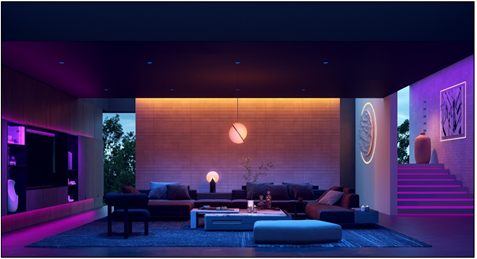
|
Figure
23 Illustrates
Dark, Colorful Lighting that Reflects the Impact or
Romantic Atmosphere Lightology (2018). |
Figure 24

|
Figure 24 Illustrate
the Design of Pendant Lighting in Different Spaces that Combine Light and Color Effects Abbattista (2025). |
Figure 25
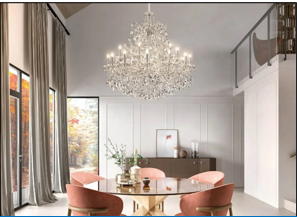
|
Figure 25 Illustrate the Design of Pendant Lighting in
Different Spaces that Combine Light and Color
Effects Abbattista (2025) |
4.4. Psychological Effects of Different Lighting Types
Human psychology is significantly influenced by
lighting, with different lighting conditions evoking distinct emotional
responses Edwards and Torcellini (2002). Additionally, the
importance of studying different types of lighting, which has a significant
impact on humans by evoking various emotions, is shown in Table 2and Table 3
Table
2
|
Table 2 Types of Lighting on Function Edwards and Torcellini (2002). |
||
|
A. The Design of
Ambient Lighting |
B. The Design of
Task Lighting |
C. The Design of
Accent Lighting |
|
|
|
|
|
Figure 26 Illustrates Ambient Lighting Allen (2024). |
Figure 27 Illustrates Task Lighting Allen (2024). |
Figure 28 Illustrates Accent Lighting Lightology (2018). |
|
It acts as the primary light source, producing consistent light.
Ambient lighting has a significant impact on a room's overall atmosphere.
While softer lighting might promote relaxation, bright ambient light can
foster openness and dynamism, as shown in Figure 26 |
This lighting is designed for tasks such as working or reading. It
lessens eye strain and enhances attention. Task lighting is crucial in home offices and study areas, as shown in Figure 27, to improve productivity. |
Accent lighting can accentuate a space's unique qualities and create a
sense of drama, as shown in Figure 28, Lightology (2018). |
Table 3
|
Table
3 Types of Lighting and Aesthetic Factors Edwards and Torcellini (2002). |
||
|
Warm Lighting |
Cool Lighting |
Natural
Lighting |
|
|
|
|
|
Figure 29 Illustrates Warm Lighting Lightology (2018). |
Figure 30 Illustrates Cool Lighting Lightology (2025). |
Figure 31 Illustrates Natural Lighting Allen (2024). |
|
Warm light creates a cozy, intimate atmosphere by emulating the
natural tones of sunsets, as shown in Figure 29, Lightology
(2025). |
Commercial settings, such as offices and retail stores, frequently
employ cool, bright lighting (between 4000K and 5000K) to promote focus and
alertness. This type of lighting can give a room an energetic feel and
simulate natural daylight. However, prolonged exposure to cool light may
occasionally increase stress levels if not properly balanced, as shown in Figure 30, Lightology
(2025). |
In living and working spaces, natural light is particularly crucial as
it can boost productivity and foster a sense of openness to the outside
world, as shown in Figure 31, Lightology
(2025). |
5. Technique and Methods in Lighting Design
5.1. Sustainable Lighting Design
Sustainable lighting design is an
approach that prioritizes energy efficiency, environmental responsibility, and
human well-being. It involves utilizing techniques and technologies that reduce
energy consumption and minimize negative environmental impacts while providing
sufficient lighting to enable people to perform their tasks comfortably and
safely. In addition, sustainable lighting design often incorporates natural
lighting strategies, such as utilizing natural light to supplement or replace
electric lighting and lighting controls that enable users to adjust lighting
levels according to their needs. However, the responsibility of a sustainable
lighting designer goes beyond these immediate considerations. It also includes
using recycled or renewable materials in fixtures and systems, reducing light
pollution by controlling the direction and intensity of light, and integrating
lighting into a building’s overall energy management strategy. Sustainability in
lighting design refers to the practice of designing lighting systems that are
environmentally and socially responsible while meeting a space’s functional and
aesthetic requirements, as shown in Table
4, Ozenen (2023).
Table 4
|
Table 4 Key Features of Sustainable Lighting
Design Ozenen (2023). |
|
|
Energy Efficiency |
Sustainable lighting design prioritizes
energy efficiency to reduce energy consumption and mitigate environmental
impacts of lighting systems Ozenen (2023). |
|
Daylight Harvesting |
Sustainable lighting design employs
daylighting strategies to optimize natural light sources and decrease the
need for artificial lighting Ozenen (2023). |
|
Reduce Light Pollution |
Sustainable lighting design minimizes
light pollution by reducing the amount of light that escapes into the sky or neighboring properties Ozenen (2023). |
|
Use of Environmentally Friendly
Materials |
Sustainable lighting utilizes
environmentally friendly materials, including recycled and biodegradable
components Ozenen (2023). |
|
Lighting Controls |
Sustainable lighting design utilizes
lighting controls to adjust lighting levels according to occupancy, daylight
availability, and user preferences, thereby reducing energy consumption Ozenen (2023). |
|
Human-Centered
Lighting |
Sustainable lighting prioritizes the
health and well-being of building occupants by utilizing lighting that
supports circadian rhythms and promotes productivity Ozenen (2023). |
|
Maintainability and Serviceability |
Sustainable lighting design prioritizes
systems that are easy to maintain and service, reducing waste and promoting
sustainability Ozenen (2023). |
5.2. The Importance of Lighting Design for Well-Being through Biophilic Design
Interior design emphasizes the importance of lighting
in human well-being, as poor lighting can cause headaches, eye strain, and
anxiety, while thoughtful lighting enhances focus, sleep, and overall happiness
Boyce (2003). Biophilic design utilizes
sunlight, green walls, and skylights, and professional lighting designers
balance brightness, color, contrast, and glare
control to ensure visual comfort Ozenen (2023). Biophilic design emphasizes the
connection between natural and constructed environments, utilizing natural
light to create healthier interiors through the strategic placement of lighting
fixtures, large windows, and reflective surfaces, as
shown in Figure 32, Figure 33, Boyce (2003).
Figure
32
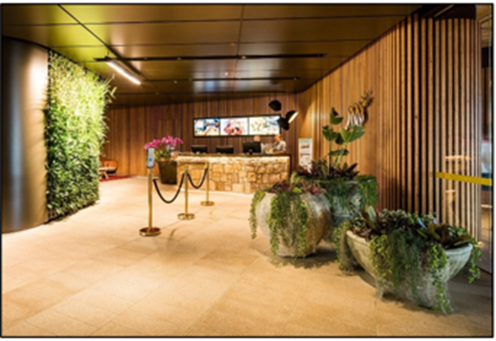
|
Figure
32 Illustrates
Biophilic Design that Utilizes Natural Lighting in the Spaces to Enhance
Well-Being Sculptform (2021). |
Figure 33
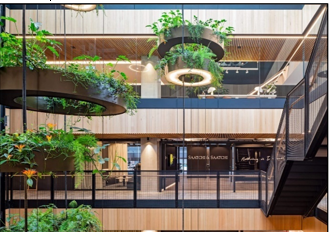
|
Figure
33 Illustrates Biophilic Design that Utilizes Natural Lighting in the
Spaces to Enhance Well-Being Sculptform (2021). |
Fluctuating light mimics circadian
rhythm, connecting us to the outdoor environment and enhancing visual comfort
by maximizing natural light throughout the day, as shown in Figure 34, Figure 35, Figure 36, Figure 37, Figure 38, Figure 39, Figure 40, Sculptform (2021).
Figure 34

|
Figure
34 Illustrates
Natural Light in the Landscape Space Marchese (2024). |
Figure 35
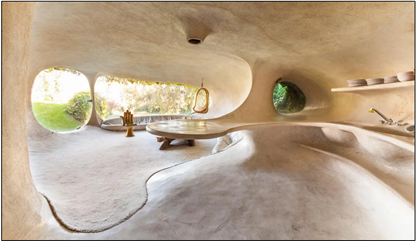
|
Figure
35 Illustrates
Organic Shapes and Emphasizes How Biophilic Design Employs Natural Light to
Improve Human Lives Marchese (2024). |
Figure 36
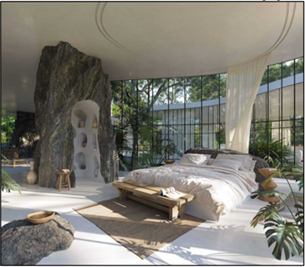
|
Figure
36 Illustrates
Sunlight, Green Walls, and Glare Control to Ensure Visual Comfort in the
Spaces Marchese (2024). |
Figure 37
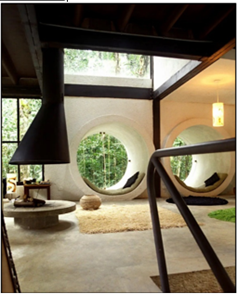
|
Figure
37 Illustrates Sunlight, Green Walls, and Glare
Control to Ensure Visual Comfort in the Spaces Marchese (2024). |
Figure 38
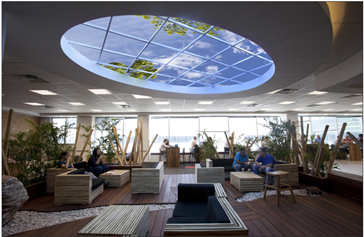
|
Figure
38 Illustrates
the Skylights and Professional Lighting Balance Brightness, Color, and Contrast in the Space Snapshots (2024). |
Figure 39

|
Figure
39 Illustrates Design Lighting in the Living Spaces
that Enhance Concentration and Well-Being for Users Edwardgeorgelondon (2024). |
Figure 40

|
Figure
40 Illustrates Design Lighting in the Living Spaces
that Enhance Concentration and Well-Being for Users Edwardgeorgelondon (2024). |
5.3. The Power of Circadian Lighting
Modern lighting design increasingly takes
into account the human circadian rhythm, the body's natural cycle of
alertness and sleep. Circadian lighting systems can adjust the color temperature of the light throughout the day, using
warmer light in the evening and more extraordinary light during the day. This
tactic is particularly useful in interior environments where people spend a lot
of time, such as hospitals, schools, and workplaces. Lighting in homes has a
significant impact on our daily lives, affecting our cooking experiences,
reading, and overall safety, as shown in Figure 41, Hunsaker (2023).
Figure
41
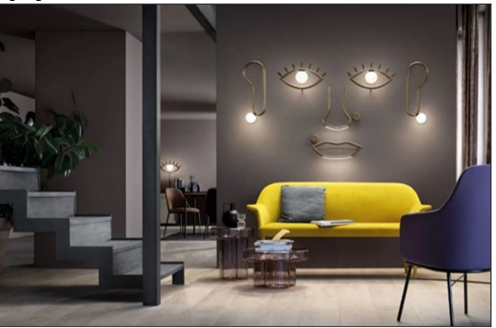
|
Figure
41 Illustrates
Creative Design that Presents Different Experiences in the Living Space Abbattista (2025). |
6. Technological Advances in Lighting Design
With the advent of LED and innovative lighting
technologies, interior design lighting has undergone a significant
transformation. Built-in LED lighting seamlessly integrates with modern
designs, transforming spaces into artistic expressions. It enhances ambiance
and functionality, contributes to energy efficiency, and is popular for
contemporary interiors. Built-in LED lighting can effectively manage heat
emissions by generating less heat compared to traditional incandescent bulbs
and incorporating advanced thermal management systems, making them suitable for
residential and commercial settings, as
shown in Figure 42, Figure 43, Figure 44, Lightology (2025).
Figure
42
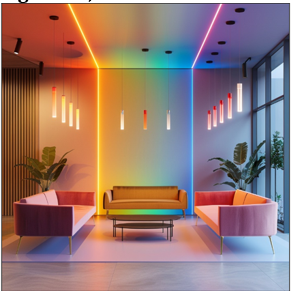
|
Figure
42 Illustrates
Colorful LED Technology in Lighting Design that
Creates an Impressive Atmosphere in the Spaces Edwardgeorgelondon
(2024). |
Figure 43
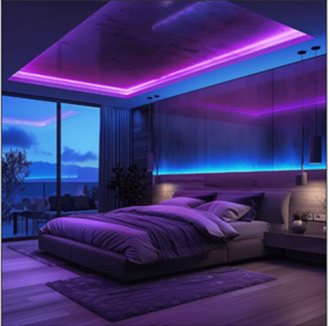
|
Figure
43 Illustrates Colorful LED
Technology in Lighting Design that Creates an Impressive Atmosphere in the
Spaces Edwardgeorgelondon (2024). |
Figure 44
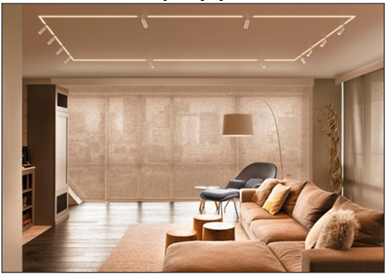
|
Figure
44 Illustrates A Modern Track and Monorail Lighting
Solution that Offers Versatile, Stylish, and Practical Lighting for Walls,
Featuring Multiple Track Head Options and Continuous Runs Lightology (2018). |
Emphasize the product’s innovative features,
functionality, and environmental sustainability, highlighting its suitability
to meet customer needs. Emphasize the company’s values to build brand loyalty,
capitalizing on the design sector’s openness to various motivations. Abbattista (2025)
Built-in LED lighting offers several advantages over
traditional incandescent bulbs, including reduced energy consumption, longer
lifespan, and better color rendering. Additionally,
LED lights require fewer replacements and provide a more vibrant and
true-to-life color experience, making them a
cost-effective solution for homes, as
shown in Table 5, Lightology (2025). They are often made last in design, resulting in
constraints and budget considerations. The complexity of product
industrialization is frequently underestimated. 11.
Table
5
|
Table 5 Technological Advances in Lighting Design Types Edwards and Torcellini (2002). |
|
|
Smart Lighting |
Energy Efficiency |
|
|
|
|
Figure 45 Illustrates Smart Lighting in Interior Design Lightology (2025). |
Figure 46 Illustrates LED Technology in Living Room Space Lightology (2018). |
|
Intelligent lighting systems can be configured to replicate natural
light patterns, enhancing productivity and overall well-being, as shown in Figure 45, Lightology
(2025). |
Thanks to advancements in LED technology, lighting is now more
environmentally friendly and energy efficient. Contemporary designers can
produce energy-efficient, aesthetically pleasing, environmentally conscious,
and practical lighting designs that contribute to a building's certification
as a green building, as shown in Figure 46, Lightology
(2025). |
6.1. Warm Dim Technology as a Sustainable Lighting Solution
Warm Dim LED technology offers a more soothing
ambiance than traditional incandescent and halogen bulbs, providing a more
comfortable and relaxing atmosphere for nighttime activities.
Warm Dim technology is integrated into many LED
suspensions and lamps, providing a relaxed setting in various settings,
including living rooms, bedrooms, kitchens, restaurants, and boutique hotels.
Energy-efficient, compatible with modern fixtures, and easy to retrofit, it
enhances the lighting experience and fosters a deeper emotional connection, as
shown in Figure 47, Figure 48, Figure 49, Lightology (2025).
Figure
47
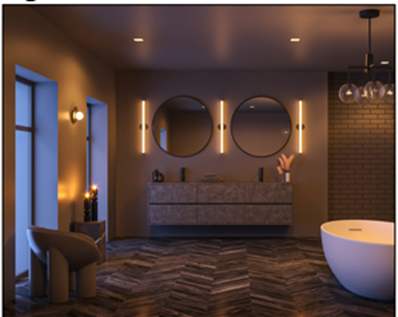
|
Figure
47 Illustrates
Warm Dim Technology Lightology (2025). |
Figure 48
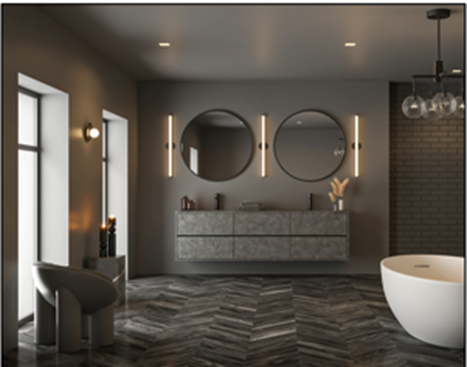
|
Figure
48 Illustrates Warm Dim Technology Lightology (2025). |
Figure49
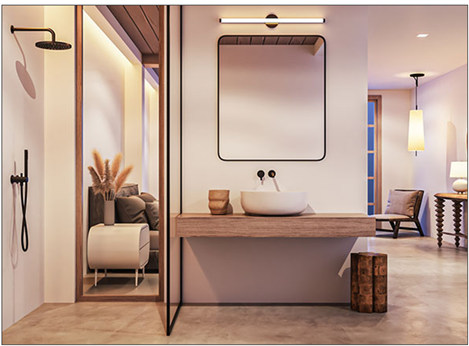
|
Figure
49 Illustrates LED
Lamps, Providing A Relaxed Environment through Warm Dim LED Technology Lightology (2025). |
7. Real Project Applications for
Lighting Psychology
Several case studies demonstrate how thoughtful
lighting design impacts human psychology, as illustrated in Table
6, Table
7, and Table 8.
Table
6
|
Table 6 Illustrate Case Studies of Lighting Applications
Inc (2011). |
||
|
Case Study 1
Google’s Office Design |
||
|
|
Description of
Project |
Lighting Design |
|
7.1 |
Lighting design plays a significant role in Google's well-known
emphasis on employee well-being at its offices worldwide. Combining
energy-efficient LED lighting, natural light sources, and adjustable task
lighting creates a well-balanced workspace that increases productivity. This
method highlights the importance of having a variety of illumination sources
available to support various activities throughout the day, as shown in Figure 50 |
Figure 50 Illustrates Google’s Office Design Interior Inc (2011). |
Table
7
|
Table 7 Illustrate Case Studies of Lighting Applications. |
||
|
Case Study 2
Healthcare Facilities |
||
|
|
Description of
Project |
Lighting Design |
|
7.2 |
The illumination in medical institutions is intended to help patients
heal and feel less stressed. Research has demonstrated, for instance, that
patients recovering in rooms with abundant natural light typically experience
less pain and require fewer prescription medications than those in rooms with
less light. Using circadian lighting systems in these settings helps maintain
a sense of time, facilitating better sleep and overall recovery, as shown in Figure 51. |
Figure 51 Illustrates the Interior Design of Healthcare. |
Table
8
|
Table 8 Illustrate Case Studies of Lighting Applications Pymnts (2016). |
||
|
Case Study 3:
Starbucks Reserve Roastery, Seattle |
||
|
|
Description of
Project |
Lighting Design |
|
7.3 |
The Starbucks Reserve Roastery in Seattle features an immersive
lighting design that enhances the sensory experience of coffee tasting. The
combination of accent lighting focused on the brewing apparatus and natural
light streaming through large windows creates a pleasing ambiance. This
thoughtful lighting design encourages customer engagement and enhances the
overall experience, as shown in Figure 52. |
Figure 52 Illustrates Warm Lighting Design in Starbucks Pymnts (2016). |
8. RESULTS AND DISCUSSIONS
8.1. A Case Study, Design Psychology Course Workshop, OCMT
A case study of a workshop in a design
psychology course (603203) at the Department of Design, Oman College of
Management and Technology, will be presented. The workshop's goal was to apply
psychological concepts and lighting design principles in retail store spaces
and investigate how lighting affects customers in fashion stores. The
workshop's conclusions, which examined consumer psychology through various
lighting design techniques, were exceptional. A comprehensive color and light strategy, developed through pre-design
workshop, layouts, and professional leadership, is crucial for ensuring the
desired visual impact and user experience performance, as shown in Table
9.
Table 9
|
Table 9 The Workshop Projects of Design
Psychology Course (603203) in the Department of Design, Oman College of Management
and Technology (OCMT) OCMT (2024). |
|||
|
Projects: Rendering
Different 3D Fashion Retail Stores to Measure the Impact of Lighting Color on Consumers Using AI Tools OCMT (2024). |
|||
|
8.1.1 Workshop Description |
|||
|
The workshop discusses a study examining the impact of lighting colors on consumer behavior in
3D fashion retail stores. Students will utilize AI tools to develop virtual
models of various retail environments with distinct lighting scenarios. The
goal is to measure the effects of these lighting variations on consumers'
shopping experiences, mood, purchase intentions, and store ambiance. The
workshop enhances customer engagement and sales. The findings can help
optimize store designs and lighting, leading to increased customer
satisfaction and sales OCMT (2024). |
|||
|
8.1.2
Workshop Aims |
|||
|
The workshop explores the impact of lighting color
on consumer behavior in fashion retail store
design. The workshop involves creating realistic 3D visualizations of various
store layouts to simulate different lighting conditions through AI tools. It
also examines how lighting color affects product
views, with warm lighting creating a cozy atmosphere and more astonishing
lighting enhancing a modern or sleek appearance. The workshop aims to foster
an understanding of how shoppers respond to these lighting colors, including their emotional reactions and
purchasing decisions. The use of AI tools helps identify patterns and
correlations between lighting color and consumer behavior. The findings could help students make informed
decisions about store design and lighting strategies to improve customer
engagement and increase sales. The students created various examples of
lighting design based on the same given plan. Additionally, these results
demonstrate the impact of color lighting on
consumers in fashion store design, as illustrated in the given floor plan for
the store (Figures 53, 54)
OCMT (2024). |
|||
|
Figure 53 Illustrate the Given Fashion Store Floor Plan in the Workshop, Including Aan Area of 10 M² × 10 M² OCMT (2024). Figure 54 Illustrate the Given Fashion Store Floor Plan in the Workshop, Including Aan Area of 10 M² × 10 M² OCMT (2024). |
|||
|
8.1.3 Workshop Results, Including 3D Modeling
with Rendering. |
|||
|
N |
Lighting
Design and Color |
The study of Impact color
lighting on consumer |
Project |
|
8.1 |
Pink
and White LED Lighting |
·
Pink lighting,
associated with romance and femininity, creates a soft, inviting atmosphere
that appeals to young women and women's fashion stores, as shown in Figure 55, OCMT (2024). The results of the design: ·
Provide influence consumer behavior
and brand perception. ·
Create a welcoming atmosphere. ·
Appealed to female demographics. ·
Enhance visual merchandising. ·
Establish strong brand identity. Create
psychological effects. |
Figure 55 Illustrate a 3D Render of the Fashion Store with Pink and White LED Lighting OCMT (2024) |
|
8.2 |
Black
and Pink LED Lighting |
·
Pink lighting
enhances clothing and accessories' visual appeal, creating vibrant colors and textures and establishing a brand's identity
and emotional connection with customers, as shown in Figure 56,
OCMT (2024). The results of the design: ·
Create a balance of sophistication and warmth. ·
Create visually striking space. ·
Cater to diverse consumer preferences. ·
Increase foot traffic and sales. Enhance
consumer experience, engagement, and sales. |
Figure 56 Illustrate a 3D Render of the Fashion Store with Pink LED Lighting OCMT (2024). |
|
8.3 |
Pink
and Black LED Lighting |
·
Pink lighting
influences consumer behavior by creating a warm,
inviting atmosphere that promotes comfort, relaxation, and playfulness,
thereby encouraging more extended store visits and increased merchandise
engagement. , as shown in Figure 57, OCMT (2024). The results of the design: ·
Emphasize clarity and a modern aesthetic. ·
Add warmth and approachability. Enhance the
shopping experience, optimize product visibility, and align with brand
identity. |
Figure 57 Illustrate a 3D Render of the Fashion Store with Pink LED Lighting OCMT (2024). |
|
8.4 |
Light
pink LED Lighting |
·
Pink lighting
is connected to romance and femininity, as shown in Figure 58,
OCMT (2024). The results of the design: ·
Influence consumer perceptions. Drive sales and
enhance brand loyalty. |
Figure 58 Illustrate a 3D Render of the Fashion Store with Light Pink LED Lighting OCMT (2024) |
|
8.5 |
White
and Light Purple LED Lighting |
·
Purple lighting
adds refinement and exclusivity, appealing to customers looking for
distinctive trends, as shown in Figure 59, OCMT (2024). The results of the design: ·
Enhance aesthetic appeal. ·
Influence consumer emotions. Drive
purchasing decisions. |
Figure 59 Illustrate a 3D Render of the Fashion Store with White and Light Purple LED Lighting OCMT (2024) |
|
8.6 |
Green
and Yellow LED Lighting |
§ Green lighting is linked
to nature and calm, spotlights eco-friendly goods, and creates a refreshing
atmosphere that fosters peaceful and harmonious shopping, as shown in Figure 60, OCMT (2024). The results of the design: ·
Create an environment that is both energetic and
calming. ·
Draw customers in, encouraging them to browse. ·
Highlight products or areas. ·
Influence purchasing decisions. Shape consumer
perceptions and behaviors. |
Figure 60 Illustrate a 3D Render of the Fashion Store with Yellow and Green LED Lighting OCMT (2024). |
|
8.7 |
Yellow
LED Lighting |
·
Yellow lighting,
a cheerful and optimistic color, can evoke feelings
of happiness and impulse buying; however, excessive brightness can cause eye
strain and discomfort, as shown in Figure 61, OCMT (2024). The results of the design: ·
Creates a joyful environment. ·
Enhance product visibility. Encourage more
extended shopping experiences. |
Figure 61 Illustrate a 3D Render of the Fashion Store with Yellow LED Lighting OCMT (2024) |
|
8.8 |
White
with Light Orange LED Lighting |
·
Orange lighting,
which combines red energy and yellow happiness, is energetic and playful,
making it ideal for casual fashion brands or collaborative spaces that
stimulate enthusiasm and social interaction, as shown in Figure 62,
OCMT (2024). The results of the design: ·
Create a visually stimulating environment. ·
Attract customers. ·
Enhance the shopping experience. Align with
brand values. |
Figure 62 Illustrate a 3D Rendering of the Fashion Store with White Light Orange LED Lighting OCMT (2024). |
|
8.9 |
Black
with Orange LED Lighting |
·
Orange lighting,
which blends yellow joy with red energy, is lively and fun, making it perfect
for casual fashion businesses or group areas that encourage excitement and
social engagement, as shown in Figure 63, OCMT (2024). The results of the design: Enhance
ambiance, attracting high-end consumers, but excessive use can be heavy or
intimidating if not balanced with other elements. |
Figure 63 Illustrate a 3D Rendering of the Fashion Store with Orange LED Lighting OCMT (2024) |
|
8.10 |
Off-white
LED Lighting |
·
Off-white lighting
creates a cozy, inviting atmosphere that enhances the appearance of products
and fosters positive feelings about merchandise, complementing various
styles, as shown in Figure 64,
OCMT (2024). The results of the design: ·
Enhance aesthetics. ·
Shape consumer experiences. Encourage
sales. |
Figure 64 Illustrate a 3D Render of the Fashion Store with Off-white LED Lighting OCMT (2024) |
|
8.11 |
White
with Gray and Yellow LED Lighting |
·
Gray lighting
creates a neutral, sophisticated backdrop, evoking calmness and stability
while highlighting colors without overpowering
them. It conveys a trendy and contemporary style, appealing to
fashion-forward shoppers, as shown in Figure 65, OCMT (2024). The results of the design: ·
Influence consumer perception and behavior. ·
Enhance the shopping experience. Influence
purchasing decisions. |
Figure 65 Illustrate a 3D Rendering of the Fashion Store with white and Yellow LED Lighting OCMT (2024). |
|
8.12 |
White
with Black and Red LED Lighting |
·
Red lighting,
which is linked to passion and excitement, can effectively highlight
promotional displays and create a sense of urgency, but too much of it can be
overbearing, as shown in Figure 66,
OCMT (2024). The results of the design: ·
Create dynamic, visually appealing environments. ·
Enhance product visibility and influence purchase
decisions. Transform the
store into an immersive experience that fosters brand loyalty. |
Figure 66 Illustrate a 3D Rendering of the Fashion Store with white and Red LED Lighting OCMT (2024). |
|
8.13 |
Blue
LED Lighting |
·
Blue lighting
evokes a sense of calmness and trust, making it ideal for luxury brands and
promoting relaxation in consumers during purchasing decisions, as shown in Figure 67, OCMT (2024). The results of the design: ·
Enhance customer experience. ·
Influence product perception. ·
Drive sales through psychological and aesthetic
effects. Combine with
layout, decor, and music. |
Figure 67 Illustrate a 3D Render of the Fashion Store with Blue LED Lighting OCMT (2024) |
|
8.14 |
Black
and Purple LED Lighting |
·
Purple lighting,
associated with luxury and creativity, enhances sophistication and
exclusivity, making it ideal for high-fashion areas and showcasing premium
products, appealing to consumers seeking unique styles, as shown in Figure 68,
OCMT (2024). The results of the design: ·
Influence product perception. ·
Create an inviting atmosphere. Enhance the
shopping experience. |
Figure 68 Illustrate a 3D Render of the Fashion Store with Purple LED Lighting OCMT (2024) |
|
8.15 |
Black
and Green LED Lighting |
·
Green lighting,
associated with nature and tranquility, creates a
refreshing ambiance that promotes harmony and peace, encourages leisurely
shopping, and highlights eco-friendly brands, as shown in Figure 69, OCMT (2024). The results of the design: ·
Create a dynamic visual experience. ·
Guide consumer attention. ·
Highlight highlighted products. ·
Promote the brand's sustainability and luxury values. Enhance
aesthetic appeal and align with shoppers' emotional motivations. |
Figure 69 Illustrate a 3D Render of the Fashion Store with Green LED Lighting OCMT (2024) |
|
8.16 |
Black
with Pink and Blue LED Lighting |
·
Blue lighting
evokes calmness and trust, making it ideal for luxury brands and promoting
relaxation in consumers during purchasing decisions OCMT (2024). ·
Pink lighting, often associated with romance and femininity,
creates a soft, inviting atmosphere that appeals to young women and women's
fashion stores, as shown in Figure 70. The results of the design: ·
Cater to fashion trends. ·
Elicit emotional responses. ·
Promote customer engagement. ·
Enhance brand identity and consumer engagement. Promote more
extended visits and potential sales. |
Figure 70 Illustrate a 3D Rendering of the Fashion Store with Pink and Blue LED Lighting OCMT (2024). |
|
8.17 |
Black
and Red LED Lighting |
·
Red lighting,
which is often associated with passion and excitement, can draw attention to
promotional displays and instill a sense of
urgency. However, excessive use of red in promotional displays can be
overwhelming, as shown in Figure 71, OCMT (2024). The results of the design: ·
Enhance the shopping experience. ·
Influence purchasing decisions. Contribute to
store brand identity. |
Figure 71 Illustrate a 3D Render of the Fashion Store with Red LED Lighting OCMT (2024) |
|
8.18 |
Black
and White Lighting |
·
White lighting
creates a modern atmosphere, enhances visibility, and creates an inviting
atmosphere, making clothing and accessories more appealing and vibrant, as
shown in Figure 72,
OCMT (2024). The results of the design: ·
Enhance aesthetic value. ·
Shape consumer experience and behavior. ·
Communicate brand values. Influence
purchasing decisions. |
Figure 72 Illustrate a 3D Render of the Fashion Store with White Lighting OCMT (2024) |
9. CONCLUSIONS AND RECOMMENDATIONS
Lighting is a crucial element of interior design as it defines how people interact with space, in addition to being practical. By understanding the psychological effects of various lighting schemes, designers can create visually appealing settings that promote mental well-being. Balancing artificial and natural illumination, incorporating biophilic elements, and considering cultural aspects, as well as circadian rhythms, can significantly enhance the quality of interior settings. By understanding both elements' psychological and design aspects, designers can create visual and functional locations that enhance the occupants’ experience and comfort. Incorporating relevant color schemes and lighting solutions can help improve interior design projects, ensuring harmony, comfort, and overall satisfaction.
In conclusion, making the right choice can significantly enhance the shopping experience, guide consumer behavior, and effectively promote brand identity. The workshop on design psychology course in OCMT, Department of Design, focused on Color lighting in fashion stores, which can significantly influence consumer behavior and mood. Blue lighting evokes a sense of calmness and trust, making it an ideal choice for high-end brands. Green lighting suggests harmony and peace, encouraging leisurely exploration and contemplation. Yellow lighting evokes happiness and optimism, ideal for youthful brands. Orange lighting evokes energy and joy, making it a suitable choice for casual fashion brands. Purple lighting evokes luxury and exclusivity, perfect for high-fashion areas. White lighting enhances product visibility and promotes the modern aesthetic. Pink lighting, associated with romance and femininity, creates a soft, inviting atmosphere, particularly effective in stores targeting young women or women's fashion. Furthermore, designers must consider the psychological impact of light in alignment with the space's intended purpose. The perfect lighting design creates a well-balanced workspace that increases productivity. Further research on this topic is crucial for understanding and effectively applying light theories in interior design.
CONFLICT OF INTERESTS
None.
ACKNOWLEDGMENTS
None.
REFERENCES
Abbattista, P. (2025). Decorative Lighting
Industry.
Allen, A. M. S.
(2024). Open Kitchen
Lighting.
Almrsal. (2024). Barstools Kitchen
Island Lighting.
Boyce, P. R. (2003). Human Factors in Lighting. Crc Press. https://doi.org/10.1201/9780203426340
Edwardgeorgelondon. (2024). The Ultimate
Guide on how to Create and Master the Modern Color Palette.
Edwards, L., & Torcellini, P. (2002). Literature Review of the Effects of Natural Light on
Building Occupants. https://doi.org/10.2172/15000841
Elnaggar, H. B. J. J. o. D. S., & Arts, A.
(2022). Illumination and Color
in Interior Design of Living Room, 3 (1), 50–63. https://doi.org/10.21608/jdsaa.2021.76256.1112
Hunsaker, C. (2023). Circadian Lighting.
Inc., G. (2011). Google Offices, Dublin.
Lightology. (2018). How to Light a Living Room.
Lightology. (2025). Future of Lighting.
Lightology. (2025). Lighting Measurements
for Installation.
Lightology. (2025). Warm Dim Technology.
Madumarova, M. J. G. I. I. R. J.
(2023). The Influence of Color and Light on Interior Spaces:
An Analysis of Psychological
and Design Perspectives, 11 (11), 210–212.
Mahmoud, N. A.
(2023). The Lighting
Effects on the Tactile Perception in Interior Design Studios. In EDULEARN23 Proceedings.
IATED.
Marchese, K. (2024). Biophilic Design Guide - Kellert's Principles and the Benefits
of Nature.
Oman College
of Management and Technology (OCMT). (2024). Workshop Projects of the Design
Psychology Course (603203) in the Department of
Design, Sultanate of Oman. Tools of Design.
Ozenen, G. (2023). Lighting Sources used for Interior Design. In
Architectural Interior Lighting (pp. 37–49). Springer. https://doi.org/10.1007/978-3-031-49695-0_5
Pymnts. (2016). Starbucks Invests in Italian Bakery Princi.
|
|
 This work is licensed under a: Creative Commons Attribution 4.0 International License
This work is licensed under a: Creative Commons Attribution 4.0 International License
© IJETMR 2014-2025. All Rights Reserved.






